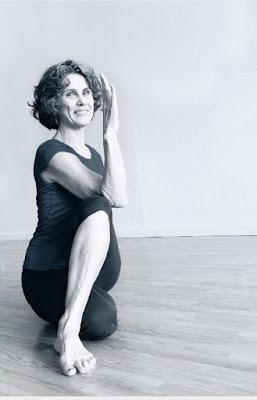
Barbara Haxo Phillips, Age 64
You know flexionand extension
and side-bending, too;
but do you recall…
the most famous spinal movement of all? (dup-a-dup, dup, dup, dup do-dooo!)
Okay, I ‘m obviously starting to get into the holiday spirit, and you are right—spinal rotation is not really the most famous spinal movement of all, but it is an essential movement for all yoga poses that involve a little or a lot of twisting. These include seated twists, such as Sitting Twist (Parsva Sukasana), and Marichi’s pose 3 (Marichyasana 3), reclined twists, such as Belly Turning pose (Jathara Parivartasana), and forward bending twists, such as Revolved (Parivritta Janusirsasana—check name). There are also several standing twists, such as Revolved Triangle pose and Revolved Extended Side Angle pose, but all the asymmetrical standing poses require at least a little rotation, including Triangle pose (Trikonasana), Extended Side Angle pose (Utthita Parsvakonasana), Warrior 1 and Warrior 2 (Virabradrasana 1 and 2) and Pyramid pose (Parsvokonasana). The same is true for the asymmetrical seated forward bends and backbends.
As with the other three movements of the spine (forward bending, side bending, and back bending), different areas of your spine are better at rotating than others. The ability of these areas rotate are, in descending order: your neck (cervical spine), the intersection of your lower ribs and the upper part of your lower back (your thoraco-lumbar junction), and your lower lumbar spine, which is capable of very little rotation. It is important not to expect a restricted area to be more mobile than it is and not to force movement especially in the restricted low back area.
There are a few conditions for which any twisting at all should be avoided, including poses that include just an element of twisting like Triangle pose. (There is a bit of wiggle room here, if you can do a modified Triangle pose or Head to Knee Forward Bend without provoking symptoms, you can probably safely do a small amount of rotation. But if these types of poses worsen symptoms, you should avoid all twisting of any kiind.) There are also many conditions for which you should avoid deeper twisting but doing a gentle twist is fine. In general, a gentle twist is one that takes you only 50 to 75 percent of your full capacity. Poses that include an element of twisting, such as Triangle and Head to Knee Forward Bend, fall into the category of a gentle twist.)
Who should avoid any twisting of the spine? Those with:
- Degenerating or bulging disks with symptoms that worsen with twisting (see Degenerative Disk Disease and Yoga)
- Arthritis anywhere in the spine with symptoms that worsen with twisting (see Arthritis of the Spine).
- Spinal stenosis with symptoms that worsen with twisting (see A Pair of Serendipities Re Spinal Stenosis).
- Second and third trimester of pregnancy.
- Abdominal conditions with symptoms that worsen with twist. Common conditions include Inflammatory Bowel Disease, Irritable Bowel Syndrome, Hiatal Hernia, constipation, and Reflux disease.
- Osteopenia and osteoporosis (keep in mind that Loren Fishman, MD, feels that his osteoporosis study subjects actually did quite well with basic twisting poses)
- Acute nausea
- Untreated high blood pressure. Avoid long holds of standing twists such as Revolved Triangle pose (Parivritta Trikonasana) and Revolved Half Moon pose (Parivritta Arda Chandrasana).
- Sacroiliac pain that worsens with twisting
- Lower back pain
- Scoliosis. Those who have different rotational ability on their left and right sides due to their underlying spinal structure may need to twist to different amounts on each side. On the side on which you can twist more easily, I recommend not rotating maximally but instead focusing on lengthening your spine. On the restricted side, I recommend mindfully encouraging more rotation, but without pushing too hard.
- After a holiday feast!

